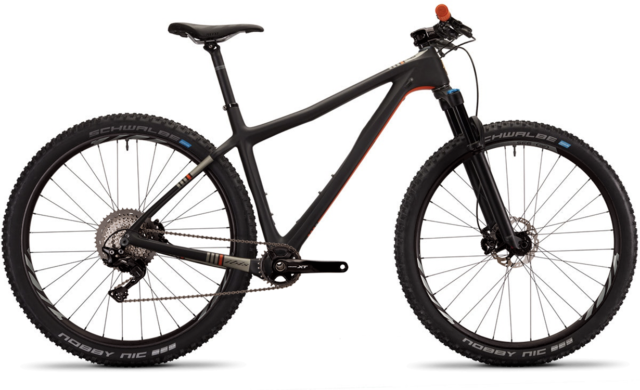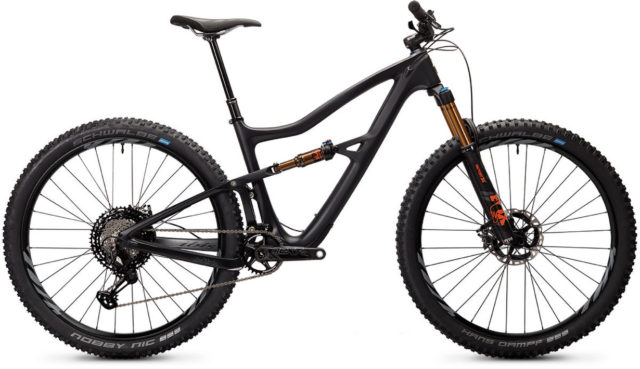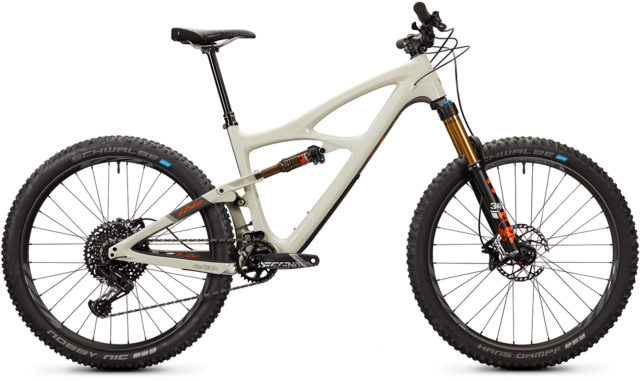

Intro
When considering a new mountain bike, there are so many similar-looking bikes on the market being made by so many different companies, it is virtually impossible to (1) know where to begin; (2) quickly figure out which one or two products from a given brand might work well for you; and (3) determine what products from other brands might be the most similar and also worth considering.
So in our new “Blister Brand Guide” series, we provide an overview of the entire product lineup of a brand; highlight how each product stands out from the rest of that brand’s lineup; and help you figure out quickly and easily which bike might work best for you.
In our individual product reviews, we go very deep into the details of particular products. With these Brand Guides, the goal is not Depth, but Breadth. Our Brand Guides and full reviews are designed to complement each other — provide a broad overview of entire company lineups, and then also very detailed reviews of individual products.
Our mountain bike Brand Guides are presented by CBGTrails. Learn more and start planning your trip today at cbgtrails.com, then download the CBG Trails app for info on the 750+ miles of singletrack and 150+ trails in Crested Butte and the Gunnison Valley, Colorado.
See our other MTB Brand Guides
About Ibis
Ibis was started in 1981 in California. It was founded by one of the early mountain biking pioneers, Scot Nicol. Nicol sold the company in 2000, and it then went bankrupt. But Ibis returned in 2005 after Nicol partnered with other industry vets to bring back the company. Ibis is now 100% owned by five of its employees. Ibis has made many different types of bikes throughout the years, and today, they only make mountain and gravel bikes with only 1 aluminum-framed bike — the rest of their lineup features carbon frames. Ibis also makes wheels and rims.
Each of their build kits features a handful of available upgrades and options. These allow you to prioritize spending money for more performance on individual components of the build kit and cater a given build to your own preferences. The prices listed below are the base price for each build without any upgrades, but you can click on the name of each bike to see all of the available upgrade options.
Ibis is currently headquartered in Santa Cruz, California.
Current Warranty (for the original retail purchaser)
- Seven years for frames and rims manufactured after January 1st, 2016
- Two years for hubs
- One year for paint and finish
- Replacement parts available at a minimum charge for non-warranty situations
- For more information, visit Ibis.
Ibis’ Suspension Design: DW-link
(For more on different suspension designs, see our Suspension 101 article)
Build Options: Where to Spend & Where to Save Your Money?
Before we get into their specific models and build options, here are some things to keep in mind when deciding on which build level to go with, and why.
First, when looking at complete bikes, suspension and wheels are going to make the biggest difference in how a bike really rides. Spend money on those before other things like higher-end drivetrain parts, cockpit parts (e.g., stem, handlebars, etc.), cranks, etc.
Tires make an enormous difference in performance, but are cheaper and easier to upgrade, especially since they tend to wear down quicker than other components. Upgrading a lower-end front tire to something better — and saving the original for rear-tire use — can be a good way to improve a bike while still making use of the originals, since front tires are generally a lot more important than rear tires when it comes to traction.
Drivetrain parts can be upgraded piecemeal as they wear out, or if you just want to upgrade down the line. Higher-end cassettes are mostly just lighter, while higher-end shifters and derailleurs get lighter, smoother, and sometimes last a bit longer as you go up in price.
How to Use our Blister Brand Guide
We’ll outline here the different models in Ibis’s MTB lineup, organized from most cross-country-oriented (XC) to downhill-oriented (DH). In other words, the bikes at the top of the list are optimized to pedal and climb uphill very well, while the bikes at the bottom are optimized to handle very rough, steep, and challenging descents very well.
We’ve included some notable information for each model:
Available build kits & their MSRP
- Best Budget Build: These are the build kits that we think make the most sense for people trying to spend the least amount without ending up with a build that’s going to immediately break or need to be upgraded.
- Most Performance for the Price: These are the build kits that we think make the most sense for people seeking the best balance of performance and cost. I.e., if you don’t need to get the cheapest bike, but you also don’t need the absolute lightest bike or all the newest bling, this is the build we think makes sense for you.
- Suspension travel (e.g., 100 mm of travel, 130 mm of travel, etc.)
- Wheel size (e.g., 27.5”, 27.5+, 29”)
- Frame material options (e.g., alloy vs. carbon)
- A brief description of what the bike was designed for and any notable design details.
- Some of the bike’s most direct competitors from other brands
- Which Ibis bike it’s most similar to
- Reasons why you should buy it
- Reasons why you should not buy it
Ibis Mountain Bikes
(Most Cross-Country-Oriented to Most Downhill-Oriented)
Ibis DV9
Geometry

- Front: 100-120 mm
- Rear: Hardtail
- 29″
- Carbon
This hardtail is designed to be very versatile with geometry similar to a trail bike and generous tire clearance. It’s less XC-racing-oriented than many hardtails. [Editor’s Note: the DV9 has been discontinued since publishing.]
Consider If:
- You appreciate hardtails, but want one that has slightly more aggressive geometry
- You want a do-it-all hardtail
- You often ride trails that are slightly steep, bumpy, and technical
Don’t Bother If:
- You often ride very steep, fast, technical, bumpy trails
- You like a bike that is more forgiving on descents than it is a good climber
- You are looking for a lightweight, XC race-style hardtail
- Sram NX Eagle: $2,499 – Best Budget Build
- Shimano SLX: $2,999
- Sram GX Eagle: $3,099
- Shimano Deore XT: $3,399 – Most Performance for the Price
- Sram XO1 Eagle AXS: $5,529
- Shimano XTR: $5,999
- Frame only: $999
Most Similar Bikes from Other Brands
- Santa Cruz Chameleon 29”
- Specialized Fuse 29”
- Kona Honzo
- Transition Vanquish
- Nukeproof Scout 290
Ibis Ripley
Geometry

- Front: 130 mm
- Rear: 120 mm
- 29″
- Carbon
The Ripley fits right in between XC and Trail categories. It has enough clearance to fit 2.6” tires.
More like the DV9 than the Mojo 3.
Consider If:
- You want a short-travel 29er that won’t be too harsh on descents
- You want a bike with a good balance of climbing ability and descending stability
- You like to ride very long distances
Don’t Bother If:
- You’re looking for a XC-race-style full-suspension 29er
- You are willing to sacrifice climbing ability for more descending capability
- Sram NX Eagle: $4,199 – Best Budget Build
- Shimano SLX: $5,099
- Sram GX Eagle: $5,399
- Shimano Deore XT: $5,799 – Most Performance for the Price
- Sram XO1 Eagle AXS: $8,199
- Shimano XTR: $9,199
- Frame only: $2,833
Most Similar Bikes from Other Brands
- Transition Smuggler
- Santa Cruz Tallboy V4 / Juliana Joplin V4
- Devinci Django 29
- Giant Trance 29
- Trek Fuel EX
- Kona Process 134 29
- Nukeproof Reactor 290
- YT Izzo
- Norco Optic
- Evil The Following MB
Ibis Mojo 4
Geometry

- Front: 140 mm
- Rear: 130 mm
- 27.5″
- Carbon
Ibis’s best Quiver Killer, designed to be their most middle-of-the-road trail bike. Updated June 2020, the new Mojo has significantly longer and slacker geometry with a steeper seattube angle. The new Mojo gets more clearance for longer dropper posts, a new lower link designed to reduce maintenance, and more frame protection. (Check out our First Look of the Mojo 4)
More like the Ripmo AF than the Ripley.
Consider If:
- You are looking for a well-balanced bike in terms of climbing and descending
- You appreciate a good, long descent and are willing to climb for it
Don’t Bother If:
- You ride trails that are mostly flat and smooth
- You are looking for an XC-style bike that climbs very well
- You want a bike that is very stable and forgiving on the descent and are willing to sacrifice some climbing ability
- Shimano Deore: $4,499 – Best Budget Build
- Shimano SLX: $5,399
- Sram GX Eagle: $5,699
- Shimano Deore XT: $6,099 – Most Performance for the Price
- Sram XX1 Eagle AXS: $10,699
- Frame only: $2,999
Most Similar Bikes from Other Brands
- Specialized Stumpjumper 27.5
- Giant Trance Advanced
- Kona Process 134 27.5
- Rocky Mountain Thunderbolt
- Santa Cruz 5010 / Juliana Furtado
- Evil The Calling
- Transition Scout
- Intense Primer 27.5
- Nukeproof Reactor 275
- Devinci Troy 27
Ibis Ripmo AF
Geometry

- Front: 160 mm
- Rear: 147 mm
- 29″
- Aluminum
The Ripmo AF brings the big-wheeled Enduro speed of the Ripmo to a more affordable aluminum chassis with slightly more aggressive, modern geometry. This is the first aluminum bike Ibis has built since their 2005 resurrection. Designed to be used with either a coil or air shock. (Check out our First Look of the Ripmo AF)
More like the Ripmo V2 than the Ripmo V1.
Consider If:
- You want a bike that is capable and forgiving on the descents
- You race enduro and / or like to shuttle to the top of descents and / or ride lift-served terrain
- You want the benefits of fast-rolling 29” wheels
- You enjoy pushing your limits on fast, steep, chunky, and technical terrain
- You are on a budget looking for a good deal
Don’t Bother If:
- You ride mostly smooth and flat trails
- You are looking for a cross-country-style bike that climbs very well
- You want a more freeride style long-travel bike
- Sram NX Eagle: $2,999 – Best Budget Build
- Shimano SLX: $3,999
- Sram GX Eagle: $4,299 – Most Performance for the Price
- Frame only: $1,799
Most Similar Bikes from Other Brands
- Santa Cruz Megatower
- Rocky Mountain Instinct BC Edition
- Intense Carbine
- Nukeproof Mega 290
- Evil The Wreckoning LB
- Scott Ransom
- Canyon Strive
- Giant Reign 29
- Mondraker Foxy
Ibis Ripmo
Geometry

- Front: 160 mm
- Rear: 147 mm
- 29″
- Aluminum
Released February 2020, the Ripmo V2 shares the same progressive head tube angle, seat tube angle, and reach as the Ripmo AF. Also, the suspension leverage ratio was altered to be more progressive for coil-shock compatibility. This bike is Ibis’ latest long-travel 29” enduro offering, replacing the original Ripmo.
More like the Ripmo AF than the Mojo HD5.
Consider If:
- You want a bike that is capable and forgiving on the descents
- You race enduro and / or like to shuttle to the top of descents and / or ride lift-served terrain
- You want the benefits of fast-rolling 29” wheels
- You enjoy pushing your limits on fast, steep, chunky, and technical terrain
Don’t Bother If:
- You ride mostly smooth and flat trails
- You are looking for a cross-country-style bike that climbs very well
- You want a more freeride style long-travel bike
- Sram NX Eagle: $4,399
- Shimano SLX: $5,199
- Sram GX Eagle: $5,499
- Shimano Deore XT: $5,899
- Sram XO1 Eagle AXS: $8,299
- Shimano XTR: $9,299
Most Similar Bikes from Other Brands
- Santa Cruz Megatower
- Rocky Mountain Instinct BC Edition
- Intense Carbine
- Nukeproof Mega 290
- Evil The Wreckoning LB
- Scott Ransom
- Canyon Strive
- Giant Reign 29
- Mondraker Foxy Carbon
Ibis Mojo HD5
Geometry

- Front: 170 mm
- Rear: 153 mm
- 27.5″
- Carbon
Ibis’ most downhill-capable bike. New for model year 2020, the HD5 features more aggresive geometry and a longer fork than the Mojo HD4 it replaced. (Check out our First Look of the Mojo HD5)
Consider If:
- You want a bike that is capable and forgiving on the descents
- You race Enduro and / or like to shuttle to the top of descents and / or ride lift-served terrain
- You enjoy pushing your limits on fast, steep, chunky, and technical terrain
- You prefer the nimble feeling of 27.5″ wheels
Don’t Bother If:
- You ride mostly smooth and flat trails
- You are looking for a cross-country-style bike that climbs very well
- You prefer faster-rolling 29″ wheels
- Sram NX Eagle: $4,399 – Best Budget Build
- Shimano SLX: $5,199
- Sram GX Eagle: $5,499
- Shimano Deore XT: $5,899 – Most Performance for the Price
- Sram XO1 Eagle AXS: $8,299
- Shimano XTR: $9,299
- Frame only: $2,999
Most Similar Bikes from Other Brands
- Santa Cruz Nomad
- Pivot Firebird
- Transition Patrol
- Rocky Mountain Slayer
- Nukeproof Mega 275
- Norco Range 27.5”
- Devinci Spartan 27
- Cannondale Jekyll
- Giant Reign
